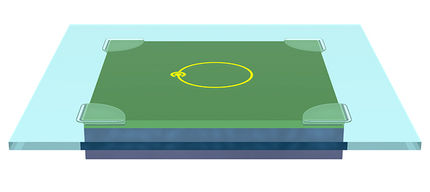Graphene joins the race to redefine the ampere
A new joint innovation by the National Physical Laboratory (NPL) and the University of Cambridge could pave the way for redefining the ampere in terms of fundamental constants of physics. The world's first graphene single-electron pump (SEP), described in a paper in Nature Nanotechnology, provides the speed of electron flow needed to create a new standard for electrical current based on electron charge.
The international system of units (SI) comprises seven base units (the metre, kilogram, second, Kelvin, ampere, mole and candela). Ideally these should be stable over time and universally reproducible. This requires definitions based on fundamental constants of nature which are the same wherever you measure them.
The present definition of the Ampere, however, is vulnerable to drift and instability. This is not sufficient to meet the accuracy needs of present and certainly future electrical measurement. The highest global measurement authority, the Conférence Générale des Poids et Mesures, has proposed that the ampere be re-defined in terms of the electron charge.
The frontrunner in this race to redefine the ampere is the single-electron pump (SEP). SEPs create a flow of individual electrons by shuttling them in to a quantum dot – a particle holding pen – and emitting them one at a time and at a well-defined rate. The paper published describes how a graphene SEP has been successfully produced and characterised for the first time, and confirms its properties are extremely well suited to this application.
A good SEP pumps precisely one electron at a time to ensure accuracy, and pumps them quickly to generate a sufficiently large current. Up to now the development of a practical electron pump has been a two-horse race. Tuneable barrier pumps use traditional semiconductors and have the advantage of speed, while the hybrid turnstile utilises superconductivity and has the advantage that many can be put in parallel. Traditional metallic pumps, thought to be not worth pursuing, have been given a new lease of life by fabricating them out of the world's most famous super-material - graphene.
Previous metallic SEPs made of aluminium are very accurate, but pump electrons too slowly for making a practical current standard. Graphene's unique semimetallic two-dimensional structure has just the right properties to let electrons on and off the quantum dot very quickly, creating a fast enough electron flow - at near gigahertz frequency - to create a current standard. The Achillies heel of metallic pumps, slow pumping speed, has thus been overcome by exploiting the unique properties of graphene.
The scientist at NPL and Cambridge still need to optimise the material and make more accurate measurements, but the paper marks a major step forward in the road towards using graphene to redefine the ampere.
The realisation of the ampere is currently derived indirectly from resistance or voltage, which can be realised separately using the quantum Hall effect and the Josephson Effect. A fundamental definition of the ampere would allow a direct realisation that National Measurement Institutes around the world could adopt. This would shorten the chain for calibrating current-measuring equipment, saving time and money for industries billing for electricity and using ionising radiation for cancer treatment.
Current, voltage and resistance are directly correlated. Because we measure resistance and voltage based on fundamental constants – electron charge and Planck's constant - being able to measure current would also allow us to confirm the universality of these constants on which many precise measurements rely.
Graphene is not the last word in creating an ampere standard. NPL and others are investigating various methods of defining current based on electron charge. But the paper suggests graphene SEPs could hold the answer. Also, any redefinition will have to wait until the Kilogram has been redefined. This definition, due to be decided soon, will fix the value of electronic charge, on which any electron-based definition of the ampere will depend.
The paper will also have important implications beyond measurement. Accurate SEPs operating at high frequency and accuracy can be used to make electrons collide and form entangled electron pairs. Entanglement is believed to be a fundamental resource for quantum computing, and for answering fundamental questions in quantum mechanics.
Malcolm Connolly, a research associate based in the Semiconductor Physics group at Cambridge, says: "This paper describes how we have successfully produced the first graphene single-electron pump. We have work to do before we can use this research to redefine the ampere, but this is a major step towards that goal. We have shown that graphene outperforms other materials used to make this style of SEP. It is robust, easier to produce, and operates at higher frequency. Graphene is constantly revealing exciting new applications and as our understanding of the material advances rapidly, we seem able to do more and more with it."

































































